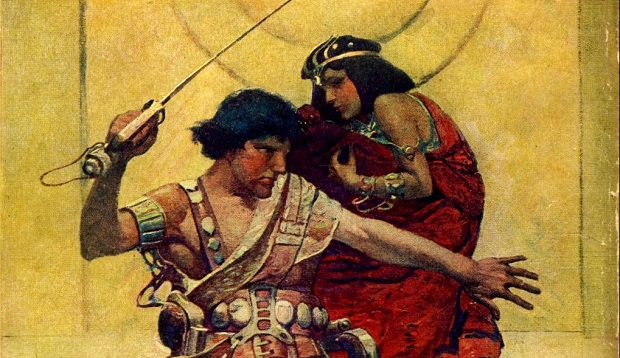As with Finn J.D. John’s other annotated omnibus that I devoured, Robert E. Howard’s Conan the Cimmerian Barbarian, The John Carter Trilogy was a pleasure to imbibe. Since I was traveling in August, I listened
As with Finn J.D. John’s other annotated omnibus that I devoured, Robert E. Howard’s Conan the Cimmerian Barbarian, The John Carter Trilogy was a pleasure to imbibe. Since I was traveling in August, I listened to all three novels on Audible. The reading was excellent, and I enjoyed John’s introduction as well as his annotations that shed extra light on the text between each installment of the opening Carter trilogy.
I didn’t know much about Burroughs work before diving into A Princess of Mars, and I was immediately impressed with his detailed world-building. The man had quite an imagination, and I can think of no greater compliment to pay an author. While I could see how Burroughs would come up with some of the Red Martians technology, their airships seem like a logical leap from the airplanes and blimps of 1912, I was blown away by the fact that Mars had a factory to produce its oxygen. Both major races introduced in the first novel are richly developed with unique cultures that stand out as distinct from the one lived in by Burroughs. The Green Martians are a particularly fascinating warrior race, and the reader fully understands their way of life via John Carter’s journey through their world.
Of the three novels in this collection, The Gods of Mars stands out the most because the scale of the story is so large. I’ll keep my descriptions vague to avoid spoilers, but in the novel, Carter exposes the truth behind a religious ceremony that Martians have taken part in for generations. Burroughs piqued my interest in this religious ceremony in A Princess of Mars, and I was extremely happy to see this become the main subject of the second novel. While I’ve read that many people consider The Gods of Mars to be one of, if not the best, John Carter tale, I do disagree slightly. While I greatly enjoyed the second Carter book, I think A Princess of Mars is a complete tale, while The Gods of Mars ends on a cliff hanger that is the subject of The Warlord of Mars.
The third book is the least interesting as it essentially follows John Carter trying to rescue a damsel in distress for the entirety of the story. This is a major plot point of the previous two novels as well, but Burroughs does a better job of balancing out the princess saving with interesting technology, new societies, and fascinating characters. The lack of Tars Tarkas’s presence in the third tale is also keenly felt as Carter bounces around Mars without any real friends for most of the story. Tars is a richly developed ally for Carter because of how much the reader gets to know him in A Princess of Mars, but he essentially cameos in the third book after a large role in the second. I was also slightly disappointed that the frame narrative that Burroughs wraps around the Carter stories isn’t concluded at the end of The Warlord of Mars, which makes me feel like the story isn’t complete even though the text has ended.
Overall, these stories are a foundational part of classic pulp literature. It’s not surprising that people are still fans of Carter today. I recently had the pleasure of attending PulpFest, and I met a ton of Burroughs enthusiasts at that event. After delving into these first Carter tales, I can see why they are so devoted. If you’re already a fan of Burroughs, you might be interested to learn that Edgar Rice Burroughs Inc. is producing new canonical novels set within his connected literary universe in 2020. So, while Burroughs is a keystone of pulp’s past, he’s also continuing to influence pulp’s future.

If this was your introduction to Burroughs, it’s a good one, the same I had many years ago, thanks to my father. Just don’t let it be the last time you read ERB or you will miss out on a multitude of great stories.
The Tarzan series, for example, is filled with wonderful yarns but people either confuse them with the Disney cartoon or listen to those who dismiss Burroughs as “racist, sexist, colonialist” and never bother. I recommend you read all the John Carter and Tarzan stories (just not all at once); as you say, they are a cornerstone of Pulp. But if you do read Tarzan of the Apes, be sure to read The Return of Tarzan right afterwards; they are two halves of one story.